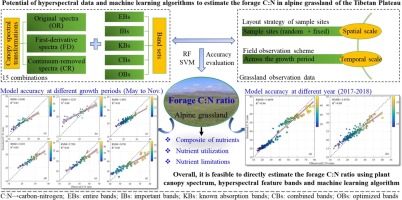ISPRS Journal of Photogrammetry and Remote Sensing ( IF 10.6 ) Pub Date : 2020-04-08 , DOI: 10.1016/j.isprsjprs.2020.03.017 Jinlong Gao , Tiangang Liang , Jie Liu , Jianpeng Yin , Jing Ge , Mengjing Hou , Qisheng Feng , Caixia Wu , Hongjie Xie

|
The carbon-nitrogen (C:N) ratio plays a crucial role in regulation of the nutrient utilization efficiency and growth rate of plants. However, challenges are faced when hyperspectral data are directly used to estimate the C:N ratio due to the lack of corresponding sensitive feature bands. This study aims to explore the feasibility of using important bands (IBs) determined for the C:N ratio and known absorption bands (KBs) of protein, chlorophyll, N, and carbon-containing compounds from hyperspectral measurements to estimate the forage C:N ratio. Random forest (RF) and support vector machine (SVM) algorithms are employed to establish a model for the estimation of the forage C:N ratio. The results show that the KBs exhibit good performance in estimating the forage C:N ratio (V-R2 of 0.70–0.80, with a mean of 0.77), and the IBs derived from the red and red-edge regions significantly contribute to the forage C:N ratio estimation, with V-R2 of 0.77–0.80. This study also demonstrates that the models based on combined bands (CBs) (the combination of KBs and IBs) slightly improve the accuracy of the forage C:N ratio estimation. Moreover, further optimization of the CBs produces satisfactory estimation of the forage C:N ratio (V-R2 = 0.82, V-RMSE = 5.53), explaining 85–92% of the variation in the forage C:N ratio at the different growth stages (May to November). Overall, the direct estimation of the forage C:N ratio in alpine grassland using hyperspectral feature bands is promising.
中文翻译:

利用高光谱数据和机器学习算法估算青藏高原高寒草原生态系统中饲草碳氮比的潜力
碳氮比在调节植物养分利用效率和生长速率中起着至关重要的作用。但是,由于缺乏相应的敏感特征带,直接将高光谱数据用于估计C:N比时面临挑战。这项研究旨在探讨使用高谱带测定的C:N比重要谱带(IBs)和蛋白质,叶绿素,N和含碳化合物的已知吸收谱带(KBs)估算饲料C:N的可行性比。采用随机森林(RF)和支持向量机(SVM)算法来建立估计草料C:N比的模型。结果表明,KBs在估计饲料C:N比方面表现出良好的性能(VR 2(0.70–0.80,平均值为0.77),并且来自红色和红色边缘区域的IB对草料C:N比率的估算有显着贡献,VR 2为0.77–0.80。这项研究还表明,基于组合带(CB)(KB和IB的组合)的模型会稍微提高草料C:N比估算的准确性。此外,牛肝菌的进一步优化产生了令人满意的草料C:N比估算值(VR 2 = 0.82,V-RMSE = 5.53),解释了不同生长阶段草料C:N比变化的85–92% (五月至十一月)。总体而言,利用高光谱特征带直接估算高寒草原牧草C:N比是有希望的。











































 京公网安备 11010802027423号
京公网安备 11010802027423号